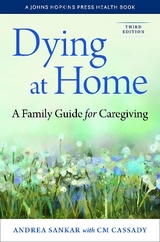
Dying at Home
Johns Hopkins University Press (Verlag)
978-0-8018-6202-1 (ISBN)
- Titel erscheint in neuer Auflage
- Artikel merken
A growing number of people choose to live their final weeks or months at home. For patients who cannot benefit from acute care in the hospital, home care offers an alternative to a nursing home or hospice. Advances in medical technology and pharmacology allow even those with serious illnesses to remain at home relatively free of pain and symptoms, and professional services are increasingly available to assist family caregivers with work that is often physically and emotionally exhausting. First published in 1991, Dying at Home examined the reasons behind this trend and offered practical advice about assuming as much control as possible over the process of dying. In this thoroughly updated edition, medical anthropologist and gerontologist Andrea Sankar keeps her focus on the patient and loved ones while providing the latest information on hospice home care teams, pain medications, HIV and AIDS, legislation on death with dignity, physician-assisted suicide, and sources of information and support for patients and families.
Dying at Home is an intimate account based on extensive interviews with family and professional caregivers as well as with other family members, friends, and patients. The author addresses the concerns and problems of those who face the decision of whether to care for a dying loved one at home, including preparing the home environment for caregiving; how to use professional caregivers in the home setting; managing the patient's pain, agitation, and other conditions; and how to recognize impending death and what to do immediately after death. She draws from stories that represent a wide range of circumstances and causes of death. At home, surrounded by family and friends in a comforting environment, patients have some control over what remains of their lives. "Home death is a powerfully significant experience," the author writes, "despite the strain, exhaustion, and conflict that sometimes accompany it. Its power lies in the fact that in the face of certain death, the caregiver can give the person life, that is, the continuation of life as a social being." Praise for Dying at Home: "A wealth of practical information and thoughtful discussion."
--Milwaukee Journal "Begins to fill our deficit of experience with accurate information and compassionately told stories."--San Francisco Chronicle "The author combines her professional knowledge of home care with her personal experience of caring for her dying mother at home. The result is a concise volume geared to the lay person that presents a clear picture of the issues, problems, and accomplishments arising from the patient's decision to die at home and the special role of the patient's caregiver."--Cathy Coyle, Social Work in Health Care "One of the book's most appealing features, beyond its sympathetic yet straightforward manner, is that it reports research while including helpful hints and extensive quotations from actual caregivers."--Jeanne E. Bader, Aging Today "Andrea Sankar tells us we have not solved the problem of caregivers' pain ...She gives voice to the caregivers of dying patients and highlights their concerns ...Andrea Sankar may be the Benjamin Spock for care of the terminally ill."--Priscilla Kissick, Hospice Journal "This book is meant for lay readers, but could serve as a valuable resource for health care professionals.
It is an outstanding reference for the physician to recommend to the family or caregiver of the patient who wants to die at home. Using a variety of illustrative case studies, Dying at Home provides useful and practical guidance for the caregivers of a dying family member or friend."--Joseph R. Stenger, Journal of Family Practice "Caring for the dying person at home is one of the most important and meaningful tasks anyone can undertake. This book is a wonderful guide toward that end. I strongly recommend it for family physicians."--Journal of the American Board of Family Practice "A powerful guide to making the emotional time of caring for a dying loved one a bit more manageable."--Solutions: Canada's Family Guide to Home Health Care & Wellness
Andrea Sankar, a medical anthropologist and gerontologist, is director of the Medical Anthropology Program in the Department of Anthropology at Wayne State University. In 1995 the Detroit News named her Michiganian of the Year for her work in HIV/AIDS.
List of Illustrations and Tables
Preface to the Revised Edition
Acknowledgements
Some Who Died At Home
Introduction
Chapter 1. Taking the Patient Home to Die
Chapter 2. Strangers in the Home: The Use of Formal Support
Chapter 3. Caregiving
Chapter 4. Social Support
Chapter 5. The Well-Being of the Caregiver
Chapter 6. Demystifying Death
Chapter 7. After Death
Conclusion. Living While Dying
Appendix A. Tasks and Problems of Caregiving
Appendix B. Additional Resources
Appendix C. Pain Medications
Appendix D. Sample Letters
Appendix E. Caregiving and HIV
Appendix F. Michigan Dignified Death Act
Glossary
Bibliography
Index
| Erscheint lt. Verlag | 25.3.2000 |
|---|---|
| Reihe/Serie | A Johns Hopkins Press Health Book |
| Zusatzinfo | 9 Line drawings, black and white |
| Verlagsort | Baltimore, MD |
| Sprache | englisch |
| Maße | 152 x 229 mm |
| Gewicht | 635 g |
| Themenwelt | Sachbuch/Ratgeber ► Gesundheit / Leben / Psychologie ► Krankheiten / Heilverfahren |
| Sachbuch/Ratgeber ► Gesundheit / Leben / Psychologie ► Psychologie | |
| Geisteswissenschaften ► Psychologie ► Trennung / Trauer | |
| ISBN-10 | 0-8018-6202-7 / 0801862027 |
| ISBN-13 | 978-0-8018-6202-1 / 9780801862021 |
| Zustand | Neuware |
| Haben Sie eine Frage zum Produkt? |
aus dem Bereich



